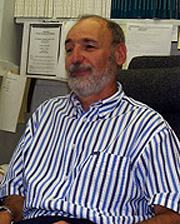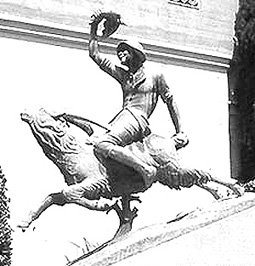
| T H E N I H C A T A L Y S T | M A Y – J U N E 2000 |
|
|
|
| C O M M E N T A R Y |
NIH RESEARCH: THE SPIRIT MAKES ALL THE DIFFERENCE
by
Joram Piatigorsky
Laboratory
of Molecular and Developmental Biology
NEI
 |
Why are you crying, son?" asked the gray-haired gentleman when he came upon a little boy in the park. The young boy was no more than five years old. He looked pitiful, with large dewdrops dripping from both eyes and his nose sniffling. He was sitting alone on the edge of the wooden bench. The boy looked up at the gentleman.
"Why are you crying?"
The boy said, "My mommy won’t let me climb on the goat statue."
"Why not?" asked the gentleman.
"She says that I could fall off and get hurt. She says that kids aren’t supposed to climb on it and if I do the other kids will want to do it too. "
"What does she want you to do at the park then?" asked the gentleman, becoming interested.
"She wants me to play with the other kids."
"Don’t you want to do that? I see a lot of kids your age running around."
"No. I want to climb on top of the goat."
"What would you do there?"
Long pause. The tears were gone now, and the little boy’s eyes had a mischievous gleam.
"I’d sit there and look around and pretend I was exploring. I did it once when my mommy wasn’t watching. Everything looked different up there. I could see across the street, and the birds seemed closer. It was exciting. I dreamed that…"
"Yes, go on. What did you dream of?"
The boy’s head drooped and then he whispered, " I’m not supposed to talk to strangers—that’s my mommy coming."
The gentleman stepped aside and watched as the little boy slid off the bench and walked sullenly away beside his mother. They passed directly in front of the goat, but the boy’s stare never budged from the pavement as they disappeared into the distance.
 Unfortunately,
I believe that many basic researchers resonate with this story. When I came
to the NIH almost 33 years ago, such a story about denying dreams and withholding
playful exploration would have been foreign to me and to my peers. It was understood
that tinkering with the unknown was the boiling pot of discovery.
Unfortunately,
I believe that many basic researchers resonate with this story. When I came
to the NIH almost 33 years ago, such a story about denying dreams and withholding
playful exploration would have been foreign to me and to my peers. It was understood
that tinkering with the unknown was the boiling pot of discovery.
Remarkable advances resulting in recombinant DNA technology have made it possible to define nearly every gene and protein in the body, and it takes little imagination to visualize the ultimate conquest of intractable diseases. I presume that there would be wide agreement that we are in the most productive phase of understanding biology that has ever existed. I hardly need to elaborate on this to the NIH audience. So then, I ask myself, "why do I feel sullen in this time of plenty?"
Looking around at my contemporaries, I realize that I am not alone. And when I observe the postdoctoral fellows, the foundation of our future, I don’t see many gleams in their eyes. Granted, work environments differ in small but important ways among the laboratories, but something is not quite right; the mood is not as it should be. Here is a typical scenario.
An eager postdoctoral fellow gets excited about a project involving gene expression during eukaryotic ellular differentiation. Her work progresses, a transcription factor is isolated, but unexpected complexity is revealed. She wants to pursue the general problem in a different organism that may give additional insight. The new experimental system is out of the mainstream, which slows down the generation of data.
Her IRTA time runs low, and the job search begins. She pursues academia, her true love, but is told that if she had a grant in hand, she would be more competitive—perhaps she could adapt her original ideas to address a disease listed as a national priority. She lets go of the fundamental problems she’d been pondering, writes an appropriate proposal, and obtains a job offer. Her proposal is funded.
She carries out a research program, but lacks the enthusiasm that drove her early scientific years. Although she will make contributions to science, she will no longer let her mind roam creatively in mysterious territory. She is not excited about her work; she is anxious to have her grant renewed.
I recognize the realities of finite resources and the desire for immediate solutions, but research in science is more than a business. There is a difference between solving a problem and discovering a new phenomenon. The former can be envisioned and exists within our conceptual framework; the latter changes our understanding of the natural world. The progress of science depends on revealing hidden phenomena.
How can we look across the street—or climb the statue and look farther—if we must always play on the pavement with everyone else, doing the same thing?
Certainly science builds on incremental additions to a growing structure of knowledge, and the present novel approaches in genetics are powerful and nothing short of extraordinary. But in my years in the intramural program, I have watched the deluge of technical advances, commercialization, and goal-oriented motives change our research landscape. The banter of daily conversation seems less driven by curiosity than it was back when messenger RNA was being discovered or the genetic code was being revealed. That era, too, as today’s, was pregnant with promises for a golden future.
Historically, the NIH intramural program has delivered innumerable scientific advances and has been a source of leadership in research throughout the world. It has done this by permitting investigators to percolate in a well-supported, academically free research environment. Now we are witnessing many creative scientists reaching out to the lucrative offers of commercially driven research. There are also pressures to make rapid links between the bench and the clinic. But one’s best work seldom springs from an assignment to meet a deadline on someone else’s agenda.
Science may benefit more
than ever today by nurturing the adventuresome spirit and curiosity that have
been the hallmarks of the NIH intramural program. If not here, then where? ![]()